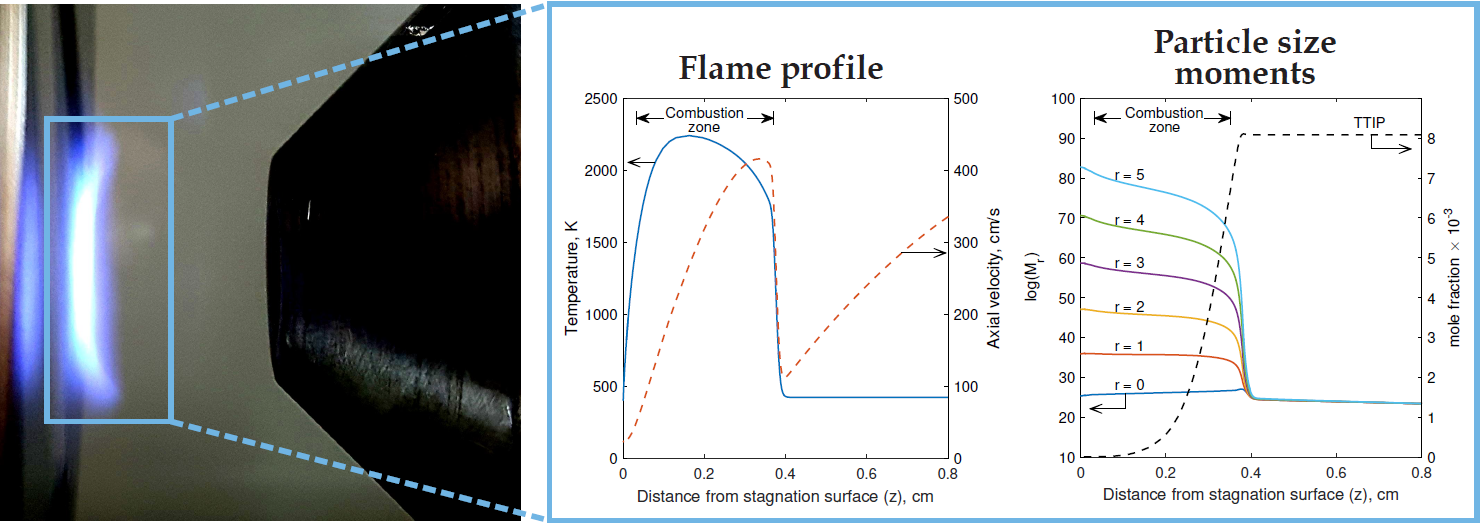Technical Report 169, c4e-Preprint Series, Cambridge
Population balance modelling of TiO2 synthesis in a stagnation flame
Reference: Technical Report 169, c4e-Preprint Series, Cambridge, 2016
- Particle population balance model of TiO2 synthesis from titanium tetraisopropoxide (TTIP) is solved using method of moments with interpolative closure (MoMIC).
- A simple reaction model for TTIP decomposition is sufficient to simulate the particle sizes in a flame stabilized on rotating surface (FSRS) experiment.
- Particle size is found to be sensitive to the sampling location near the stagnation surface, especially for high TTIP loading and stagnation temperature.
- Surface growth plays an important role in the initial growth stage of particles.
 The stagnation flame synthesis of titanium dioxide nanoparticles from titanium tetraisopropoxide (TTIP) is modelled using a population balance model based on a simple one-step decomposition mechanism and one dimensional stagnation flow. The population balance model includes nucleation, surface growth and coagulation processes and is closed using the method of moment with interpolative closure (MoMIC). The model shows excellent agreement with experimental data for different TTIP loadings in a flame stabilized on a rotating surface (FSRS). The particle size was observed to be sensitive to the sampling location in the modelled flame, offering a plausible explanation for the discrepancy between experimental particle sizes measured via aerosol sampling versus transmission electron microscopy (TEM) of samples collected using grid insertion. The sensitivity to the sampling location is found to increase with increasing precursor loading and stagnation temperature. Lastly, the effect of surface growth is evaluated by comparing the result with an alternative particle model. It is found that surface growth plays an important role in the initial stage of particle growth which results in severe under-prediction of particle size if neglected.
The stagnation flame synthesis of titanium dioxide nanoparticles from titanium tetraisopropoxide (TTIP) is modelled using a population balance model based on a simple one-step decomposition mechanism and one dimensional stagnation flow. The population balance model includes nucleation, surface growth and coagulation processes and is closed using the method of moment with interpolative closure (MoMIC). The model shows excellent agreement with experimental data for different TTIP loadings in a flame stabilized on a rotating surface (FSRS). The particle size was observed to be sensitive to the sampling location in the modelled flame, offering a plausible explanation for the discrepancy between experimental particle sizes measured via aerosol sampling versus transmission electron microscopy (TEM) of samples collected using grid insertion. The sensitivity to the sampling location is found to increase with increasing precursor loading and stagnation temperature. Lastly, the effect of surface growth is evaluated by comparing the result with an alternative particle model. It is found that surface growth plays an important role in the initial stage of particle growth which results in severe under-prediction of particle size if neglected.
Material from this preprint has been published in Combustion and Flame.
PDF (6.3 MB)



